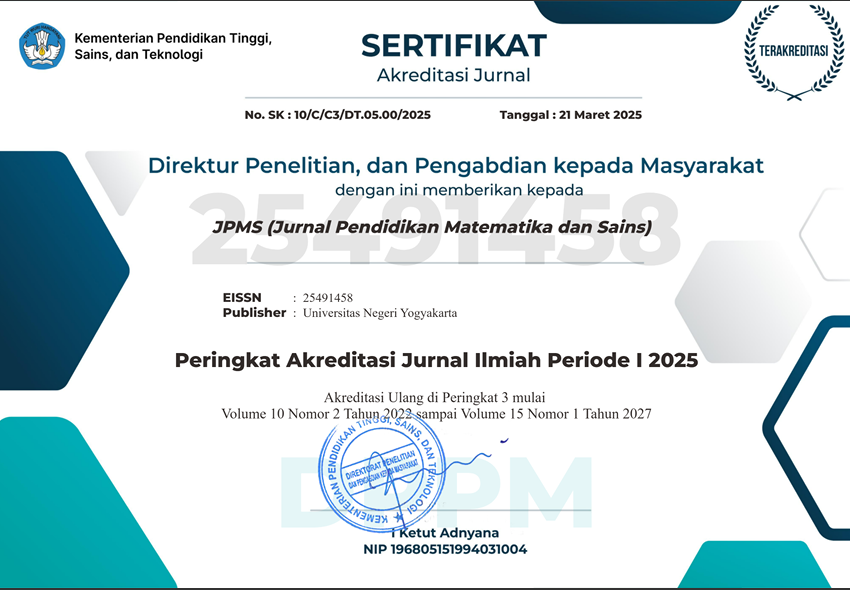Keefektifan PBL setting STAD dan TGT ditinjau dari prestasi, berpikir kritis, dan self-efficacy
DOI:
https://doi.org/10.21831/jpms.v4i1.12936Abstract
Penelitian ini bertujuan untuk mendeskripsikan: keefektifan PBL setting STAD ditinjau dari prestasi, berpikir kritis, dan self-efficacy; keefektifan PBL setting TGT ditinjau dari prestasi, berpikir kritis, dan self-efficacy; perbandingan keefektifan PBL setting STAD dengan PBL setting TGT ditinjau dari prestasi, berpikir kritis, dan self-efficacy. Penelitian ini merupakan penelitian eksperimen semu, dengan rancangan pretest-posttest non-equivalent comparison-group. Populasi penelitian mencakup seluruh siswa kelas VII MTs N Sleman Kota, dari populasi yang ada diambil secara acak dua kelas sebagai sampel penelitian. Untuk menguji keefektifan PBL setting STAD dan TGT digunakan one sample t-test. Selanjutnya, untuk membandingkan keefektifan PBL setting STAD dan TGT, dianalisis menggunakan uji T2 Hotteling's. Karena terdapat perbedaan keefektifan, maka dilanjutkan uji t-univariat. Setiap analisis dilakukan pada taraf signifikansi 5%. Hasil penelitian menunjukkan bahwa: PBL setting STAD efektif ditinjau dari prestasi, berpikir kritis, dan self-efficacy; PBL setting TGT efektif ditinjau dari prestasi, berpikir kritis, dan self-efficacy; PBL setting TGT lebih efektif dibandingkan PBL setting STAD ditinjau dari berpikir kritis. Namun, PBL setting TGT sama efektif dibandingkan PBL setting STAD ditinjau dari prestasi dan self-efficacy.
Kata Kunci: PBL setting STAD, PBL setting TGT, prestasi, berpikir kritis, self-efficacy
The Effectiveness PBL of STAD and TGT Type In Terms Of The Achievements, Critical Thinking, and Self-Efficacy
Abstract
This research aims to describe: the effectiveness PBL of STAD type in terms of the achievements, critical thinking, and self-efficacy; the effectiveness PBL of TGT type in terms of the achievements, critical thinking, and self-efficacy; comparative effectiveness the PBL of STAD type with the PBL of TGT type in terms of the achievements, critical thinking, and self-efficacy. This research was a quasi-experimental research with the pretest-posttest non-equivalent comparison-group design. The research population included all 7th grade students of MTs N Sleman Kota, from the population two classes were randomly selected as the research sample. To test the effectiveness of PBL of STAD and TGT type, the one sample t-test was used. Furthermore, to compare the effectiveness of the PBL of STAD and TGT type, the data were analyzed using the multivariate test of the T2 Hotteling's. Because there were differences in effectiveness, then further t-univariate test was done. Each analysis was performed at the significance level of 5%. The results show that: the PBL of STAD type is effective in terms of achievement, critical thinking, and self-efficacy; the PBL of TGT type is effective in terms of achievement, critical thinking, and self-efficacy; the PBL of TGT type is more effective than that using the PBL of STAD type in terms of critical thinking. But, the PBL of TGT type is as effective as that using the PBL of STAD type in terms of achievement and self-efficacy.
Keywords: PBL of STAD type, PBL of TGT type, achievement, critical thinking, self-efficacyReferences
Abdurrahman, M. (2009). Pendidikan bagi anak berkesulitan belajar. Jakarta: Rineka Cipta.
Ali, R., et al. (2010). Effect of using problem solving methode in teaching mathematics on the achievement of Mathematics Students. International Journal of Social Science, 6 (2), 68.
Arends & Kilcher, A. (2010) . Teaching for student learning: becoming an accomplished teacher. New York, NY: Taylor & Francis Group.
Arends. (2012). Learning to teach (9th ed). New York, NY: McGraw-Hill Companies, Inc.
Awofala, A. O. A., Fatade, A. O., & Ola-Oluwa, S. A. (2012). Achievement in cooperative versus individualistic goal-structured junior secondary school mathematics classrooms in Nigeria. International Journal of Mathematics Trends and Technology, 3(1), 7.
Bandura, A. (1995). Self-Efficacy in changing societies. New York, NY: Cambridge University Press.
Bassaham, G., et al. (2010). Critical thinking a student's introduction (4th edition). New York, NY: The McGrow-Hill Companies, Inc.
Bell, F. H. (1978). Teaching and learning mathematics (in secondary schools). Dubuque, Lowa: Wm. C. Brown Company.
Borich, G. D. (2007). Effective teaching methods research-based practice. Upper Saddle River, NJ: Pearson Education Inc.
Brownlie, F., et al. (2003). Enhancing learning report of the student achievement task force. British Columbia. Diakses pada tanggal 13 Mei 2015, dari http://www. bced.gov.bc.ca/taskforce/achieve_task_rep.pdf
Crawford, M. (2001). Teaching contextually: research, rationale and techniques for improving students motivation and achievement in mathematical and science. Waco, Texas: CCI Publishing, Inc.
Depdiknas. (2003). Undang-undang nomor 20 tahun 2003. Jakarta: BSNP.
Depdiknas. (2011). Laporan hasil ujian nasional SMP/MTs 2010/2011. Jakarta: BSNP.
Depdiknas. (2012). Laporan hasil ujian nasional SMP/MTs 2011/2012. Jakarta: BSNP.
Depdiknas. (2013). Laporan hasil ujian nasional SMP/MTs 2012/2013. Jakarta: BSNP.
Depdiknas. (2014). Laporan hasil ujian nasional SMP/MTs 2013/2014. Jakarta: BSNP.
Eggen, P., & Kauchak, D. (2012). Strategi dan model pembelajaran: mengajarkan konten dan keterampilan berpikir (edisi 6).Jakarta: Permata Puri Media. (Diterjemahkan oleh Satrio Wahono dari Strategie and models for teachers: teaching content and thinking skills, sixth edition). Boston, MA: Pearson Education, Inc.
Farhan, M., & Retnawati, H. (2014). Keefektifan PBL dan IBL ditinjau dari prestasi belajar, kemampuan representasi matematis, dan motivasi belajar. Jurnal Riset Pendidikan Matematika, 1(2), 227-240. doi:http://dx.doi.org/10.21831/jrpm.v1i2.2678
Frey, N., Fisher. D., & Everlove, S. (2009). Productive group work: how to engage students, build teamwork, and promote understanding. Alexandria, VA: Association for Supervision and Curriculum Development.
Kennedy, L. M., Tipps, S,. & Johnson, A. (2008). Guiding children's learning of mathematics. Belmont, California: Thomson Higher Education.
Langenfeld, T. E., & Pajares, F. (1993). The mathematics self-efficacy scale: A validation study. Paper presented at the Annual Meeting of the American Educational Research Association, April 1993, Atlanta, GA: Education Resources Information Center.
Massa, N, M. (2008). Problem-based learning (PBL): a real-world antidote to the standards and testing regime. The New England Journal of Higher Education Winter 2008, 22 (4), 19-20.
Mullis, I.V.S. et. al. (2012). TIMSS 2011 international mathematics report: findings from IEA's trends in international mathematics and science study at the fourth and eighth grades. Chestnut Hill, MA: TIMSS & PIRLS International Study Center, Boston College.
Paul, R., & Elder, L. (2008). The miniature guide to critical thinking concepts and tools. Announcing the 28th annual international conference on critical thinking. Near university of California at baerkeley. July 19-24, 2008.
Purwanti, D. E. (2013). The comparison between STAD and TGT on students achievement and motivation: senior high school. Proceeding of the Global Summit on Education, Kuala Lumpur.
Rusman. (2011). Model-model pembelajaran: mengembangkan profesionalisme guru. Jakarta: PT. Raja Grafindo Persada.
Robert, L.,& Chair, L. (2009). Student learning, student achievement: how do teachers measure up. Arlington, VA: National Board for Proffesional Teaching Standards.
Sanjaya, W. (2006). Strategi pembelajaran berorientasi standar proses pendidikan. Jakarta: Kencana.
Slavin, R. E. (2005). Cooperative Learning: teori, riset, dan praktek. Bandung: Nusa Media. (Diterjemahkan oleh Narulita Yusron dari Cooperative Learning: Theory, Research and Practice). London: Allyn and Bacon.
Solikhati, L., Maimunah, S., Malikhatun, M., Sunanto, S., & Wirabudi, B. (2010). Peningkatan hasil belajar matematika melalui model pembelajaran kooperatif tipe STAD. Jurnal Pendidikan Matematika dan Sains, 14(1), 9-14. doi:http://dx.doi.org/10.21831/jpms.v14i1.170
Stiff, L. (1999). Developing mathematical reasoning in grades K-12. Reston, VA: Yearbook (National Council of Teachers of Mathematics).
Syarifuddin. (2013). Efektivitas pembelajaran kooperatif student team achievement and tournament (STADAT) dalam pembelajaran matematika. Tesis Magister, tidak diterbitkan, Universitas Negeri Yogyakarta, Yogyakarta.
Tan, O. S. (2003). Problem-based learning innovation: using problems to power learning in the 21st century. Singapore: Cengage Learning.
The National Council of Teachers of Mathematics. (2000). Principles and standards for school mathematics. Reston, VA: NCTM.
Uden, L., & Beaumont, C. (2006). Technology and problem-based learning. London: Idea Group.
Westwood, P. (2008). What teachers need to know about. Victoria Australia: CER Press.
Zakaria, E., Chin, C. L., & Daud, Y. (2010). The effects of cooperative learning on students' achievement and attitude towards mathematics. Journal of Social Sciences, 6 (2), 272.
Zimerman, B. J. (1996). Developing self-regulated learners: beyond achievement to self-efficacy. Washington, DC: American Psychological Association.
Downloads
Published
How to Cite
Issue
Section
Citation Check
License
Jurnal Pendidikan Matematika dan Sains allows readers to read, download, copy, distribute, print, search, or link to its articles' full texts and allows readers to use them for any other lawful purpose. The journal allows the author(s) to hold the copyright without restrictions. Finally, the journal allows the author(s) to retain publishing rights without restrictions
- Authors are allowed to archive their submitted article in an open access repository
- Authors are allowed to archive the final published article in an open access repository with an acknowledgment of its initial publication in this journal

This work is licensed under a Creative Commons Attribution-ShareAlike 4.0 Generic License.





